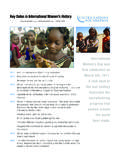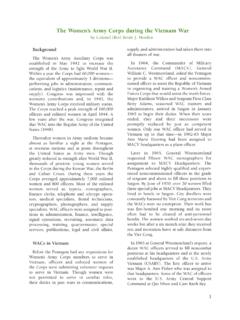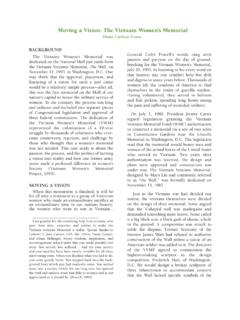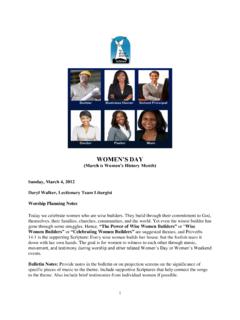Transcription of 4. Impact of Tobacco Use on Women’s Health
1 51 Gender, women , and the Tobacco Epidemic4. Impact of Tobacco Use on women s HealthIntroductionCigarette smoking was initially adopted by men in industrialized countries and was later taken up by women in those countries and men in developing countries. With the recent decline in smoking in industrialized countries, the multinational Tobacco companies have moved aggressively into the developing nations. Consequently, there is a risk of an epidemic of Tobacco -related diseases in the developing world, where Tobacco use is increasingly becoming a major Health issue for women as well as e high percentage of non-smoking women in those countries makes them an attractive target for the e Health eff ects of smoking in a population become fully pronounced only about a half-century after the habit is adopted by a sizeable percentage of young adults.
2 Th us, most of what is known about the Health eff ects of Tobacco use among women comes from studies in industrialized countries, where women began smoking cigarettes decades ago and there has been adequate time to monitor the consequences. Despite the relative paucity of epidemiological data on women in developing countries, there is no reason to think that female smokers there will be spared the serious Health eff ects of smoking. In those countries where female smoking is increasing, it may be several decades before the full Health Impact is felt, but devastating Health consequences are inevitable unless action is taken today.
3 Data from industrialized countries show that mortality of women who smoke is elevated by 90% or more compared with mortality among those who do not smoke,2 4 with evidence that risk increases as the number of cigarettes smoked and the duration of smoking increase. Th us, the risk of premature death for tens of millions of women worldwide is nearly doubled by a single factor Tobacco use that is entirely is well established that lung cancer is generally rare in populations where smoking prevalence is low and that its occurrence tends to increase following increases in smoking prevalence. Given this relationship, lung cancer mortality rates which are available for most countries of the world, even though accuracy and completeness of reporting vary considerably can serve as an indicator of the maturity of the Tobacco epidemic across populations.
4 Although this review focuses much more on lung cancer than on other smoking-related diseases, lung cancer is only one of myriad adverse Health consequences of smoking for women . Lung cancer accounted for approximately 13% of all smoking-attributable deaths among women in high-income countries in 2004;5 the remaining 87% of Tobacco s toll on women in high-income countries was due to other diseases. Moreover, lung cancer rates are a refl ection of smoking patterns two to three decades earlier, so they inadequately refl ect the more immediate Health eff ects of women s smoking, such as adverse reproductive of what is known about the Health eff ects of Tobacco is based on the smoking of manufactured cigarettes, although in some areas of the world, other forms of Tobacco use among women are common ( smoking of traditional hand-rolled fl avoured cigarettes (bidis), use of water pipes to smoke Tobacco , use of snuff and other types of smokeless Tobacco , and reverse cigarette smoking).
5 Further studies of the Health eff ects of these forms of Tobacco use are needed, although no form can be considered Moreover, many women throughout the world are involved in Tobacco agriculture and factory work. Although the literature contains descriptions of some of the toxic eff ects of handling Tobacco ,7, 8 there has been little study of the Health eff ects of employment in Tobacco production on women ; for example, eff ects of such employment on pregnancy outcomes should be investigated. However, this chapter focuses on the Health consequences of active smoking. Th e eff ects of exposure to second-hand smoke (SHS) are reviewed elsewhere in this of Smoking on women s HealthEff ects of Smoking on the Health of Infants and ChildrenTh e infants of mothers who smoke during pregnancy have birth weights approximately 200 g to 250 g lower, on average, than those of infants born to non-smoking women ,9 11 and they are more likely to be small for gesta-tional 15 Risks of stillbirth,16 19 neonatal death,16,17,20and sudden infant death syndrome (SIDS)21 24 are also Gender, women , and the Tobacco Epidemic: 4.
6 Impact of Tobacco Use on women s Health52greater among the offspring of women who smoke. In addition, it appears that breastfeeding is less common or of shorter duration among women who smoke than among non-smokers and that smokers who breastfeed may produce less breast milk than non-smokers 29 women who smoke are more likely than non-smokers to experience primary and secondary infertility and delays in to SHS has numerous effects on the Health of children, particularly relating to respiratory illnesses and ear infections, lung function, and asthma; these are reviewed elsewhere in this monograph in the chapter on SHS, women , and children.
7 Older children and adolescents who are active smokers have increased risks of respiratory illness, cough, and phlegm production; slower rates of lung growth; reduced lung function; and poorer lipid profiles than their non-smoking of Smoking on Reproduction and Menstrual FunctionWomen who smoke are more likely than non-smokers to experience primary and secondary infertility31,32 and delays in 36 women smokers who become pregnant are also at increased risk of premature rupture of membranes, abruptio placentae (premature separation of the implanted placenta from the uterine wall), placenta previa (partial or total obstruction by the placenta of the cervical os)
8 , and pre-term ,37 53 As noted above, their infants have lower average birth weights, are more likely to be small for gestational age, and are at increased risk of stillbirth and perinatal mortality than are the infants of non-smoking women . The proportion of pregnant women who smoke exceeds 30% in some populations, such as the poor and the less educated,54 64 and in light of the serious Health consequences and the strong motivation of pregnant women to ensure the Health of their newborns, efforts to help pregnant women quit smoking (and to prevent postpartum relapse) should be a high priority in public Health programmes focusing on women and studies of the effects of smoking on menstrual function, including menstrual regularity, are needed.
9 From the evidence to date, it appears that women who smoke are more likely to experience dysmenorrhoea (painful menstruation)65 68 and more severe and more frequent menopausal Early menopause is also more common among women who smoke. On average, women who are current smokers go through menopause about one to two years earlier than non-smoking 72 Effects of Smoking on Cardiovascular DiseaseIn both industrialized and developing countries, cardiovascular diseases are the major causes of death among women , as well as among ,74 women who smoke have an increased risk of cardiovascular disease, including coronary heart disease (CHD), ischaemic stroke, and subarachnoid haemorrhage.
10 Numerous prospective and case control studies document the finding that smoking is one of the major causes of CHD in ,75 81 Relative risks of CHD associated with smoking are greater for younger women than for older women . Data from the American Cancer Society s Cancer Prevention Study II (CPS II) for 1982 1986 indicate that age-adjusted relative risks of CHD were (95% confidence interval (CI) = , ) in women 35 to 64 years of age and (95% CI = , ) in women 65 years of age or In the 1980s, evidence suggested that smoking may account for a majority of cases of CHD among women in the United States under the age of Risk of CHD increases with the number of cigarettes smoked daily and with the duration of ,78 In the Nurses Health Study, current smokers who began to smoke before the age of 15 years had an estimated relative risk of (95% CI = , )

















